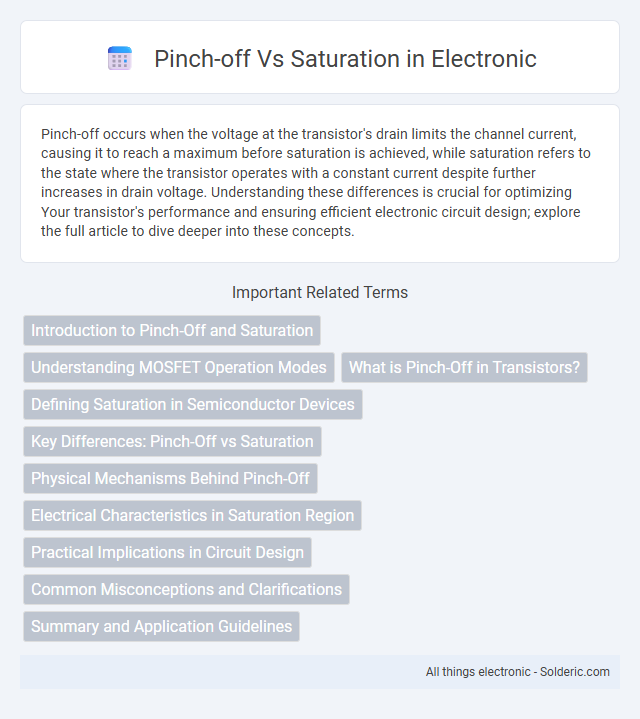Pinch-off occurs when the voltage at the transistor's drain limits the channel current, causing it to reach a maximum before saturation is achieved, while saturation refers to the state where the transistor operates with a constant current despite further increases in drain voltage. Understanding these differences is crucial for optimizing Your transistor's performance and ensuring efficient electronic circuit design; explore the full article to dive deeper into these concepts.
Comparison Table
| Aspect | Pinch-off | Saturation |
|---|---|---|
| Definition | Point where the channel is constricted, limiting current flow. | Region beyond pinch-off where current remains constant despite voltage increase. |
| Occurrence | Occurs when channel voltage drop equals gate voltage minus threshold voltage (V_DS = V_GS - V_TH). | Occurs after pinch-off in MOSFET operation. |
| Current Behavior | Current increases up to pinch-off point. | Current saturates; remains nearly constant regardless of V_DS increase. |
| Channel Condition | Channel narrows at pinch-off point but remains conductive. | Channel is pinched off near drain; current controlled by gate voltage. |
| Device Implication | Marks transition from linear to saturation region. | Defines MOSFET's saturation region crucial for amplification. |
Introduction to Pinch-Off and Saturation
Pinch-off in a transistor occurs when the voltage at the drain terminal is high enough to deplete the channel near the drain, limiting current flow despite increases in voltage. Saturation is the region where the transistor operates with a constant current, as the channel is pinched off and further increases in drain voltage do not significantly affect the current. Understanding pinch-off and saturation is crucial for optimizing your transistor's performance in analog and digital circuits.
Understanding MOSFET Operation Modes
Pinch-off and saturation describe critical MOSFET operation modes affecting current flow and voltage characteristics. Pinch-off occurs when the channel near the drain is depleted, causing the current to become constant despite increased drain voltage, defining the transition to the saturation region. Understanding these modes enables you to optimize MOSFET performance in analog and digital circuit designs.
What is Pinch-Off in Transistors?
Pinch-off in transistors occurs when the voltage at the drain terminal increases to the point that the conductive channel near the drain is constricted, limiting current flow despite further voltage increases. This effect marks the transition from the linear region to the saturation region in field-effect transistors (FETs). At pinch-off, the channel does not fully close; instead, a depletion region forms, causing the channel to pinch off and the current to remain constant as the drain voltage rises.
Defining Saturation in Semiconductor Devices
Saturation in semiconductor devices refers to the state where the current through a transistor channel no longer increases significantly with an increase in drain voltage due to the formation of a depletion region near the drain, limiting further carrier flow. Pinch-off occurs when the voltage difference between the gate and drain causes the conductive channel to narrow or "pinch" off at the drain end, marking the transition from the linear region to saturation. Understanding these concepts helps you optimize device performance for efficient current control in applications such as MOSFET operation.
Key Differences: Pinch-Off vs Saturation
Pinch-off occurs in a MOSFET when the channel near the drain depletes of carriers, causing the current to saturate despite increases in drain voltage. Saturation refers to the region where the MOSFET current remains constant regardless of further increases in drain voltage, indicating that the device has reached its maximum conduction capacity. Understanding the difference between pinch-off as a physical channel phenomenon and saturation as a stable operating region helps you optimize transistor performance in circuit design.
Physical Mechanisms Behind Pinch-Off
Pinch-off occurs in a MOSFET when the channel near the drain is depleted due to the high drain voltage, causing current saturation. This physical mechanism involves the inversion layer being "pinched off," preventing further increase in current despite an increase in drain voltage. Your device's performance depends on accurately understanding this transition between linear and saturation regions for effective transistor operation.
Electrical Characteristics in Saturation Region
In the saturation region of a MOSFET, the drain current (Id) becomes relatively independent of the drain-source voltage (Vds) and primarily depends on the gate-source voltage (Vgs) exceeding the threshold voltage (Vth). The channel is pinched off near the drain end, causing the channel length modulation effect, which slightly increases Id with Vds, but the device behaves like a current source. This region is critical for analog amplifier applications due to its stable current characteristic and high output resistance.
Practical Implications in Circuit Design
Pinch-off and saturation regions in MOSFET operation significantly influence circuit design choices, impacting amplifier linearity and switching performance. Understanding the pinch-off voltage helps you accurately predict device behavior in analog circuits, ensuring stable gain and minimal distortion. Saturation region operation is crucial for digital switching applications, optimizing speed and power efficiency in high-performance integrated circuits.
Common Misconceptions and Clarifications
Pinch-off in a MOSFET refers to the point where the channel near the drain region narrows, limiting current flow without fully stopping it, while saturation is the state where the current becomes constant despite increases in drain voltage. A common misconception is that pinch-off means the transistor is off, but in reality, the device remains on and operating in saturation mode. Understanding these distinctions clarifies that pinch-off initiates saturation, allowing you to accurately interpret MOSFET behavior in analog and digital circuits.
Summary and Application Guidelines
Pinch-off occurs when the channel in a MOSFET narrows near the drain, limiting current flow despite increasing voltage, while saturation refers to the state where the drain current becomes constant regardless of further voltage increases. Understanding these phenomena is crucial for designing analog and digital circuits to ensure proper transistor operation within specified voltage ranges. You should apply pinch-off and saturation knowledge to optimize device performance, prevent breakdown, and achieve desired amplification or switching behavior in integrated circuits.
Pinch-off vs Saturation Infographic

 solderic.com
solderic.com